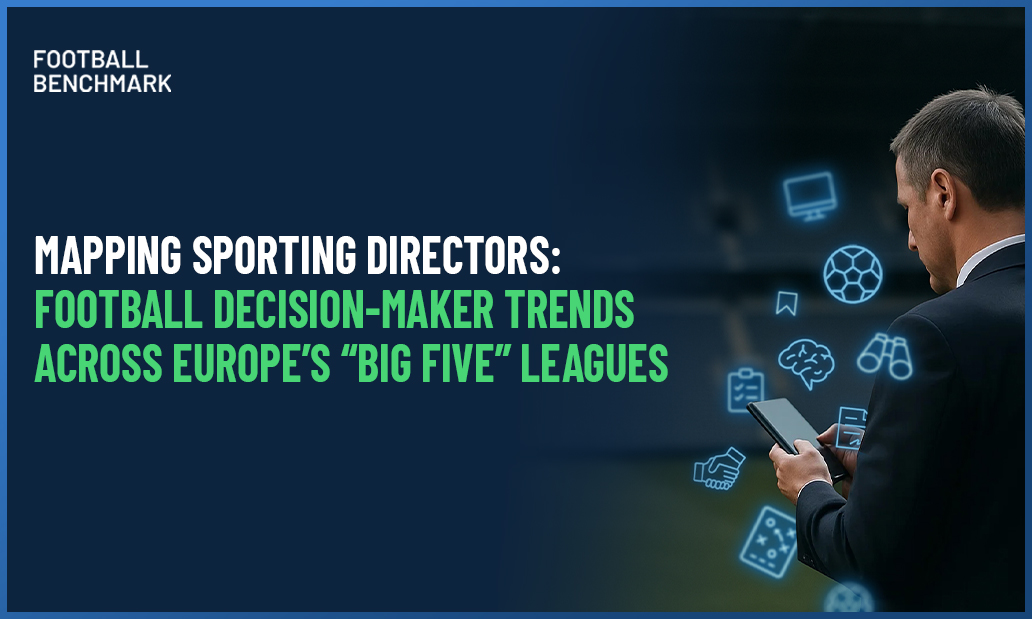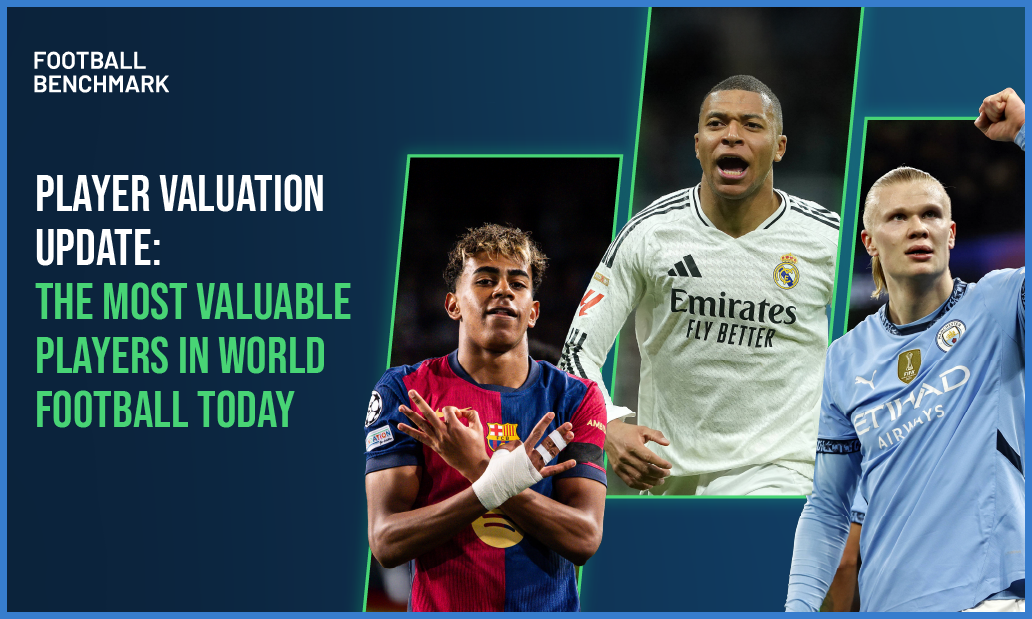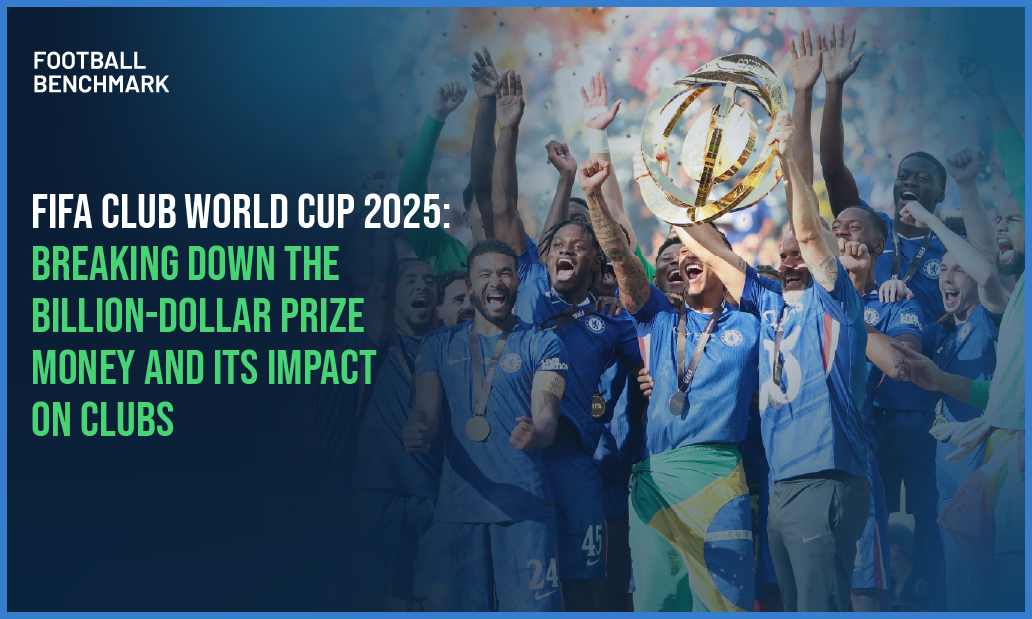
Sporting Directors have become increasingly visible in the discourse surrounding the summer transfer window, a period when their work moves into the spotlight. But their role extends far beyond player transfers. From squad building and recruitment to managing the academy pipeline and setting long-term sporting direction, Sporting Directors are now central to how clubs operate year-round.
Seen as the strategic anchor of a club’s football department, they are expected to focus on long-term planning and sporting coherence. Yet despite their growing prominence, Sporting Directors’ performance remains difficult to benchmark. Job titles vary, responsibilities differ from club to club, and the location of decision-making authority is not always consistent.
This research analyses the current landscape across the “Big Five” European leagues (the Premier League, La Liga, Bundesliga, Serie A, and Ligue 1) as of July 2025. Among the 88 Sporting Directors currently in post, it highlights who holds these roles and explores key traits such as whether they played professionally, were promoted internally, or work in their home country, offering insight into those shaping the modern game.
Reflecting the varied governance models across clubs, for the purposes of this analysis, a “Sporting Director” is defined as the senior-most figure fully dedicated to football matters.
Who are the football decision-makers?
A clear trend across the “Big Five” leagues is the prevalence of former players in the role. Two-thirds of individuals currently responsible for football decisions have a professional playing background. This profile is particularly dominant in Ligue 1, where 14 out of 18 football decision-makers are former players. The rationale is straightforward: former professionals often bring credibility, respect with stakeholders, an understanding of the player environment, and networks across the game.
Club-specific ties also influence appointments. In both the Bundesliga and Ligue 1, 6 Sporting Directors previously played for the club they now work for. These profiles can reinforce club identity and encourage supporter buy-in. However, the former player route is not without risk. Sentimental appointments often bring strong cultural alignment or club identity but may not always meet the increasing management demands of the modern role.
The Premier League stands out for its more diverse approach. Fewer than half of its Sporting Directors have a professional playing background. This may relate in part to the relatively late adoption of the role in England, where the Head Coach traditionally held primary responsibility for football matters. While club structures have since evolved, some models still see the Head Coach retain a degree of influence, with Sporting Directors often selected for their operational or strategic expertise rather than purely sporting credentials.
How are they appointed and how long do they last?
Across the “Big Five” leagues overall, around 30% of Sporting Directors were promoted internally, signalling that while internal recruitment is relatively common, the prevailing model still favours external experience. Career pathways into the role, however, vary significantly across leagues. Those promoted internally often rise through a variety of roles, such as Chief Scout or Academy Manager.
In La Liga, internal promotions account for a significant share of appointments, highlighting a league-wide emphasis on continuity and in-house development. This trend is particularly pronounced among clubs with a strong commitment to youth talent development, such as Valencia CF, Athletic Club, Real Sociedad, and Villarreal CF.
By contrast, the Premier League shows a clear preference for external hires, with recent examples such as Hugo Viana (Sporting CP to Manchester City) and Andrea Berta (Atlético de Madrid to Arsenal FC). Monchi, though appointed a couple of years earlier, similarly reflects this approach, having joined Aston Villa after highly successful tenures at Sevilla FC.
A similar trend is observed in Ligue 1, though perhaps for different structural reasons. Many French clubs operate with leaner front-office teams and a high concentration of decision-making at ownership level. As a result, internal candidates may have fewer opportunities to develop into senior football roles, making external appointments more likely when a vacancy arises.
Despite the strategic importance of the role, tenure remains remarkably short. The average Sporting Director lasts just 2.6 years. La Liga leads in stability, with an average of 3.7 years, while the Premier League sits at the lowest, with an average of 1.8 years. These timeframes raise questions about expectations and how success is measured.
Sporting Directors are responsible for building sustainable frameworks across both first teams and academies, while also protecting the club’s overall sporting vision from the volatility of short-term results. Yet with limited time in the role, many find themselves having to prioritise immediate impact over longer-term planning. The real challenge lies not just in defining a clear strategy, but in securing lasting support for it, both internally and externally.
This also raises concerns about the challenge of achieving long-term strategic alignment between ownership and Sporting Directors. Given the role’s influence over some of the club’s most impactful and costly decisions, from recruitment to overall football direction, short tenures can create structural misalignment. One area particularly affected is youth development, which depends on long-term vision and sustained commitment to build a strong pipeline of academy talent.
How much do nationality and experience shape appointments?
Sporting Directors’ nationality and experience also vary significantly across leagues, reflecting different traditions and expectations around the role.
Serie A is the most domestically focused, with 18 Sporting Directors being Italian. This reflects a strong tradition of valuing local knowledge and cultural alignment. At the other end of the spectrum, the Premier League shows the most international outlook. Only 7 English Sporting Directors are in place across six Premier League clubs, with Chelsea FC employing Co-Sporting Directors, mirroring a broader trend where domestic coaches are also less frequently appointed.
Overall, Italian nationals are the most represented, accounting for 23% of all Sporting Directors across the “Big Five” leagues. Spain (19%), Germany (17%), France (15%), and England (8%) round out the top five. Portugal leads the way among foreign nationalities, with four Portuguese Sporting Directors currently working across the “Big Five”.
The average age of Sporting Directors across the “Big Five” leagues is 48.6, ranging from 45.4 in La Liga to 51.8 in Serie A. This suggests differing views on the level of experience and seniority required for the role. It also reflects the complexity of the position, which demands a blend of technical knowledge, leadership ability, industry networks, and stakeholder management — capabilities rarely developed through a single, linear career path.
Sporting Director: A role in flux and in focus
Once primarily focused on recruitment and squad management, the Sporting Director role now spans a wide range of responsibilities, from shaping a club’s football identity and contract strategy to aligning men’s and women’s programmes, integrating academy development, managing external stakeholders, and serving as a public-facing voice alongside the executive team. Their influence stretches from the volatility of the transfer market to the long-term architecture of a club’s sporting model. But as the scope expands, so too does the need for a clear mandate and strong alignment with ownership vision.
This raises a critical question: is it realistic to expect a single individual to meet all these demands?
Some clubs are beginning to rethink whether the traditional model (one Sporting Director with full oversight) is still fit for purpose. For example, Real Madrid has long operated without a clearly defined Sporting Director role, relying on strong alignment between top management and the club’s Chief Scout, Juni Calafat. Most recently, Everton FC moved away from the single-figure approach toward a broader “Football Leadership Team” comprising specialists in technical development, talent ID, analytics, and player trading. In other cases, decision-making is distributed through transfer committees involving board members, coaches, and sporting staff — a model that has long existed in various forms. While these structures foster collaboration and risk-sharing, they can also dilute accountability and complicate execution.
Meanwhile, the rise of multi-club ownership (MCO) is transforming the role from above. In these ecosystems, Sporting Directors are increasingly expected to operate at group level, providing strategic leadership across multiple clubs. This structure can strengthen alignment with ownership but also adds governance complexity. Gianluca Nani, who oversees football strategy across both Udinese and Watford, exemplifies this evolution, with a more corporate, cross-club remit at the top and more delivery-focused Sporting Directors at individual clubs.
This shift is also reshaping the leadership pathway. As football (i.e., results, player trading, talent development) becomes increasingly central to club value creation, some ownership groups are appointing CEOs with sporting backgrounds, blurring the traditional line between business and football operations. Clubs like Internazionale, Parma Calcio, US Lecce, LOSC Lille, Olympique de Marseille, and AS Monaco reflect this approach. In such structures, Sporting Directors may adopt a more operational or advisory role, while the CEO steers the broader football strategy in closer alignment with ownership.
While clear trends are emerging — toward strategic alignment, governance innovation, and expanded expectations — there is no universal model. The most effective Sporting Director structure ultimately depends on the club’s ownership profile, governance model, strategic ambition, and operating context. A club with a hands-on owner, a multi-club network, or deep community roots may require a different leadership setup than one focused purely on performance and trading.
Understanding these dynamics is critical to designing football operations that are both resilient and aligned. The real question isn’t what a Sporting Director should look like in theory, but rather, what structure best fits each club’s unique context, goals, and evolution.
Football Benchmark can support clubs in assessing and benchmarking their organisational structures and governance models to ensure strategic alignment, helping tailor leadership frameworks to each club’s unique context and long-term ambitions.


